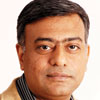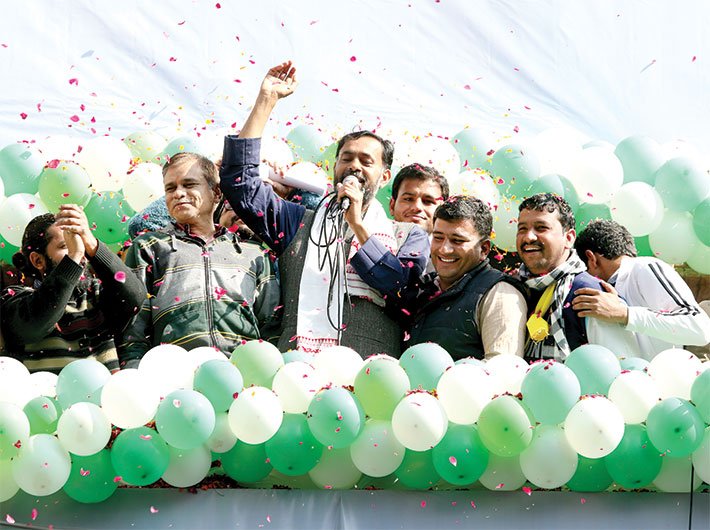Charged with anti-party activities, Prashant Bhushan and Yogendra Yadav face action by the Aam Aadmi Party. They maintain their campaign is for the party’s principles
Familiarity breeds contempt, and so does success and the story that is unfolding of the Aam Aadmi Party (AAP) is the case in point. It is also a case that proves again that in politics nobody is an “absolute friend”, something that Yogendra Yadav said during an informal meeting after he and Prashant Bhushan were voted out of the party’s political affairs committee (PAC) by 11-8 votes in the national executive (NE) meeting on March 4.
Six days later, the pro-Arvind Kejriwal group, led by Manish Sisodia, Gopal Rai, Pankaj Gupta and Sanjay Singh, issued a statement leveling serious allegations against the duo and justifying NE’s decision of removing the two founder members from the party’s highest decision-making body, PAC.
Listing out reasons behind the NE’s decision, the statement alleged that Yadav, along with Bhushan, had worked against the interests of the party and wanted AAP to lose Delhi elections so that Kejriwal could be removed as the national convener of the party. Detailing their ‘anti-party activity’, the statement said that during the Delhi assembly elections, Bhushan used to call up AAP leaders of other states asking them not to campaign in Delhi. The statement also categorically said Bhushan told AAP leaders from other states that he won’t campaign because Kejriwal needed to be taught a lesson.
What also backfired for the duo was the email campaign initiated by Bhushan’s sister Shalini Gupta, the party’s coordinator for global support and organisation development advisor, asking donors to be cautious while funding the party. The emails sent to nearly 800 NRI contacts of AAP’s global group on January 5 and 6 this year said they should be cautious in donating to the party since Kejriwal was fielding corrupt candidates in several constituencies in the Delhi election.
The fact that Prashant Bhushan and his father Shanti Bhushan openly pushed the case of Yadav as the national convener of the party – perceived by the group led by Sisodia as an attempt to “remove” Kejriwal as the party head – further triggered the campaign to oust the duo from the PAC.
The breaking point
While the Delhi election helped the party bounce back, it also seemed to have intensified the differences of opinion among the key leaders – with the face of the party Kejriwal following more of an intuitive, ad-hoc style of functioning typical of a nimble-footed young organisation while Yadav and the Bhushans pushing for a process-driven, structured approach to decision-making, including in the selection of candidates. This was something that the party had already displayed and followed when it adopted a stringent candidate selection process for the 2013 Delhi assembly election.
The process followed then by AAP, made it mandatory for candidates to be residents of Delhi and secure the signatures of 100 people each to prove their support base before they could actually submit their candidature to the party. Among other information, the party sought details of the person’s criminal history, political background, wealth, knowledge of swaraj (self-governance, a concept as propagated by Kejriwal) and participation in social movements.
Besides, a screening committee comprising AAP members was constituted to scan the applications and shortlist five candidates from each constituency. The list was supposed to be put up on various public forums, including the AAP website for feedback from the public and party volunteers. Finally, the PAC was expected to decide the candidates based on the feedback and interview of the applicants.
A key point of difference between Yadav and the Bhushans on the one side and Kejriwal on the other, was related to inter-party processes, something that got beyond the point of reconciliation when the party started to finalise its candidates for the Delhi assembly elections in November 2014. Prashant was categorically upset about the credentials of several candidates and as a member of the PAC put his foot down in 19 such cases. Eventually, the party’s Delhi complaints committee cleared seven of those names. On January 4, 2015, the remaining 12 candidates were referred to the party’s internal Lokpal or ombudsman, Admiral L Ramdas, who finally rejected two of the 12 names.
The pro-Kejriwal group, without referring to the email sent by Gupta in January to the NRI group, alleged that Prashant had tried to stop people from donating money to AAP and threatened to hold a press conference against the party. The statement also said Prashant was supporting the AAP Volunteer Action Manch (AVAM), a splinter group that had accused AAP of receiving '2 crore in 2014 through four dubious companies. Yadav, on the other hand, has been accused of planting negative stories about Kejriwal in the media.
“We cannot lower the ethical standards that we had set up as individuals and as a party, something that the electorate now wants other parties and leaders to follow. When the issue of donation was raised by AVAM, and the allegation of a hawala transaction was made, there were questions about whether the PAC had verified and approved it. We realised that there was a need to strengthen the mechanism further,” Yadav told Governance Now.
He also pointed out that the allegations of liquor recovery against the party’s Uttam Nagar candidate Naresh Balyan indicated that the party had failed to follow the right procedure and evaluation mechanism. “We must develop inner party mechanism that is quick, fair, credible and more stringent than the police to investigate such cases. Such a mechanism should also be ring-fenced from the political leadership of the party to ensure that we are able to meet the ethical standards set by us. An inquiry into the Balyan case could have been the starting point,” he said, adding that the letter written by him and Prashant was aimed at reminding the party that since the elections were over it was time to strengthen the party’s internal democratic processes.
However, it was after the February 26 informal meeting of the NE that communication between the duo and Kejriwal got completely snapped. Though leaders like Anand Kumar did try to forge a compromise formula, things did not work out. According to sources, while Prashant called up Kejriwal twice after the meeting on the day, and Yadav sent messages to him through a confidant, they did not get any response. “The raw aggression at the meeting was quite unnerving and unexpected,” said Yadav.
What is wrong with AAP?
Critics and so-called anti-Kejriwal groups point out that the party has fallen prey to the individual-driven cult culture that it was always against, defeating the very purpose for which the party was launched in 2012, something that is also reflected in the party name – the use of popular Hindi phrase Aam Aadmi that refers the common man, whose interests the AAP proposed to represent.
The party constitution was adopted on November 24, 2012 at its first meeting at the Constitution Club on November 24, 2012. It was here that the party’s National Council (NC) comprising 300 members and the NE of 23 people were formed. Both the NC and the NE were expected to have more members in due course to ensure adequate representation of people from all districts, strata and gender. Several committees were also formed to make sure that the basic principles of inter-party democracy, accountability and transparency was maintained. One of the key objectives of creating a layered decision-making structure was also to ensure nepotism did not play a role in the party.
While refusing to get drawn into making any direct comment on whether the democratic structure of the party was crumbling under the pressure of the pro-Kejriwal “Delhi group”, Yadav pointed out that the committees were formed when the other state units were being set up. “So the organisation naturally has over-representation of Delhi and is, in a way, lopsided. It also needs adequate gender and sectoral balance,” he said, adding that he and Prashant had tried to bring about the changes that were at different stages shelved by Kejriwal due to the urgency of decision making.
“We understood this and respected his decision, but once the Delhi elections were over it was time to put the house in order,” Yadav said, pointing out that the basic difference between him and Kejriwal was more about the “notion of what a political party is” rather than the issues that some in the party have been highlighting to justify his removal from the PAC. “I prefer to follow a structured, process-driven approach that follows laid-down protocols and has in-built safety mechanism with room for consultation and dissent. For Arvind, these
are bureaucratic, cumbersome and time consuming.”
This is quite symptomatic of the autocratic approach that the party has been against from day one. The fact that Kejriwal remotely managed the entire six-hour NE meeting sitting at the naturopathy hospital in Bengaluru also hints at his lack of tolerance to dissenting voices and ideas – concerns that have been voiced by former AAP leaders like Shazia Ilmi, Vinod Kumar Binny, Maharashtra’s AAP unit convener Anjali Damania and the state secretary Preeti Sharma-Menon. Damania quit the party post last year – and now from the AAP – out of frustration with the way the party was functioning.
In fact, senior AAP leader Mayank Gandhi from Mumbai, defying the gag imposed by the party, had, in his blog, highlighted that while he agreed with the issues raised by Prashant and Yadav, he decided to abstain from voting because “Arvind needs a smooth working in the PAC”. However, Gandhi expressed his shock at the resolution of removing them publicly, especially as they themselves were willing to quit.
“This decision to sack them was against the overwhelming sentiments of volunteers from all over the world,” he wrote a day after. Following his blog post, Gandhi has reportedly been targeted by a section of party members for challenging the gag order and also revealing the proceedings of the NE meet – another indication that voice of dissent has no place in the party.
Interestingly, going by the sheer numbers game and the allegations made by Dr Rakesh Parikh, a senior AAP member from Rajasthan, it is evident that the party is completely divided on the issue. The state unit, reports suggest, had passed a resolution opposing any decision on Yadav and Prashant before a proper hearing. According to Parikh, while he was not allowed to attend the meeting and vote on behalf of the state unit, the pro-Kejriwal group brought in somebody called Sunil Agiwal to represent Rajasthan and vote in favour of the motion to remove the two veterans. Had Parikh and Gandhi voted in favour of the duo, the motion would have tied at 10-10, and would have caused a major embarrassment for the party satrap.
However, all is not lost for AAP, and it is always a matter of time that foes and adversaries find a common ground to mend fences in politics. “If our departure can create more alertness about the issues then the departure has served its purpose,” said Yadav during the informal chat at his residence a day after his removal from the PAC.
Interestingly, going by the mood of the Delhi MLAs who have launched a signature campaign to remove Yadav and the Bhushans, his comment may prove more prophetic than ever.
[email protected]
(The article appears in the March 16-31, 2015, issue)



